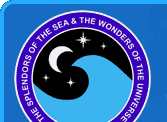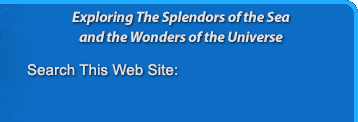1910


1912
Scripps Institute
Scripps Institution of Oceanography becomes affiliated with the University of California. Scripps is one of the world's leading marine research centers and is located in La Jolla, California, just north of San Diego. This merger with the University of California allows the institute to expand its scope to include studies of the physics, chemistry, geology, biology, and climate of Earth.

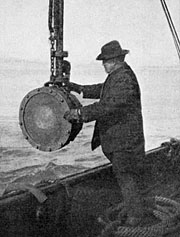
NOAA Public Domain Image
April 27, 1914
First Acoustic Exploration of the Sea Floor
Canadian inventor Reginald Fessenden uses an oscillator to bounce sound waves between an iceberg and the sea floor. This test marks the beginning of acoustic exploration of the sea. This technology will eventually lead to the development of sonar, allowing submarines to signal each other and allowing ships to detect icebergs.

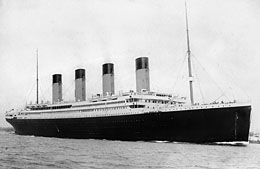
Wikipedia Public Domain Image
April 15, 1912
Titanic Sinks
The White Star Liner RMS Titanic sinks after striking an iceberg in the North Atlantic Ocean. Over 1,500 passengers lose their lives during one of the worst peacetime maritime disasters in history. This terrible tragedy leads to a concerted effort to devise an acoustic means of discovering objects in the water ahead of a moving vessel.
1920

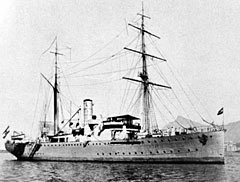
Wikipedia Public Domain Image
1925
Mapping the Ocean Floor
The German vessel Meteor sails around the Atlantic Ocean taking detailed measurements of the ocean floor using echosounding equipment. These voyages reveal new information about the shape and structure of the ocean floor.
1930

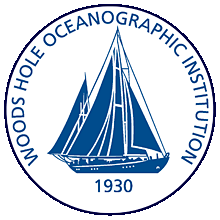
1930
Woods Hole Oceanographic Institution
In Cape Cod, Massachusetts, the Woods Hole Oceanographic Institution is founded. This private, nonprofit higher education facility will eventually become one of the world's leading oceanographic research institutions.


Wikipedia Public Domain Image
1934
First Deep Ocean Dive
William Beebe and Otis Barton embark on a deep sea expedition in a tethered sphere known as a bathysphere. They reach a depth of a 3,000 feet (914 meters) off the coast of Bermuda and discover a previously unseen world of bizarre, luminescent creatures.


NOAA Public Domain Image
1935
Sonobuoy Developed
Researchers at the Coast and Geodetic Survey invent an automatic telemetering radio sonobuoy. This instrument eliminates the need for manned station ships during Radio Acoustic Ranging (RAR) navigation operations. This sonobuoy is considered to be the first offshore moored telemetering instruments. These buoys weigh 700 pounds (317.5 kg) and can be deployed or recovered by Coast and Geodetic Survey ships in only five minutes.

1937
Bathythermograph Invented
Geophysicist and oceanographer Athelstan Spilhaus invents the bathythermograph. It is a is a small torpedo-shaped device that holds a temperature sensor and a transducer to detect changes in water temperature versus depth down to a depth of approximately 935 feet (285 meters). The invention's name stands the test of time, and is still in use today.
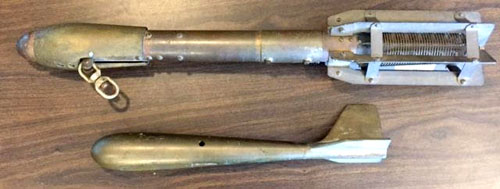
USGS Public Domain Image


Bruce A.S.Henderson / CC BY-SA 4.0
1938
Live Coelacanth Discovered
Fishermen off the coast of South Africa pull up a five-foot fish later identified as a coelacanth. This fish is a true living fossil thought to be extinct since the days of the dinosaurs. Since this discovery was made, several other live coelacanth have been discovered in African coastal waters and some have been photographed in their underwater habitat.
1940

1941
World War II Research
During World War II, electronic navigation systems are developed for precision bombing. A few years later, the Coast and Geodetic Survey conducts its first hydrographic surveys using these systems. Research during the war leads to many new tools for ocean exploration, including deep-ocean camera systems, early magnetometers, sidescan sonar instruments, and early technology for guiding Remotely Operated Vehicles (ROVs).

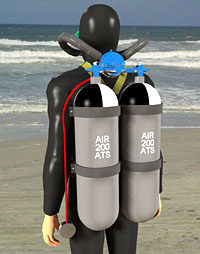
Wikipedia Public Domain Image
1943
The Aqua-Lung
Underwater explorers Jacques Cousteau and Emile Gagnan develop the first modern scuba system. They modify a breathing regulator to create the Aqua-Lung. This ground breaking invention allows divers to stay underwater for extended periods and more effectively explore the ocean realm. This single event revolutionizes the science of underwater exploration.


Bundesarchiv, Bild 102-13738
CC-BY-SA 3.0
1948
First Untethered Deep Water Craft
Swiss physicist Auguste Piccard dives in his newly designed vehicle called a bathyscaphe. Known as FRNS-2, it is the first untethered craft to carry people into the deep waters of the ocean. It sets several world diving records, beating those of the bathyspheres, since no unwieldy cable is required for diving. Piccard's son, Jacques Piccard, would soon take the bathyscaphe to the deepest point in the ocean.
1950

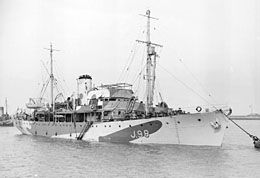
Wikipedia Public Domain Image
1951
Deepest Ocean Point Found
The British ship HMS Challenger bounces sound waves off the ocean bottom and locates what appears to be the sea's deepest point. With a depth of 35,856 feet (10,929 meters), it is named the Challenger Deep. Located off the coast of the Marianas Islands in the Pacific Ocean, the site is known today as the Mariana Trench. This trench is so deep that if you could put Mount Everest on the ocean floor, its summit would lie about a mile below the ocean surface.


Wikipedia Public Domain Image
1953
Discovery of Mid-Atlantic Ridge
American geologist Marie Tharp studies sounding profiles from the Atlantic Ocean and discovers a rift valley. Later studies reveal it to be a continuous rift extending over 40,000 nautical miles (64,373 kilometers) along the ocean floor. This discovery provides evidence for the newly formed theory of continental drift, known today as plate tectonics.

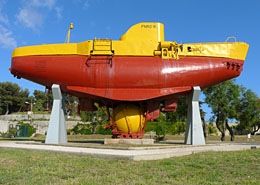
Esby / CC BY 2.0
February 15, 1954
Untethered Submersible Dive Record
The French submersible FNRS-3 sets a new record for an untethered deep sea dive as she descends to a depth of 13,290 feet (4,050 meters). The historic dive takes place in the Atlantic Ocean off the coast of Senegal in West Africa. The FNRS-3 submersible is currently on display in Toulon, a city on the French Riviera and a large port on the Mediterranean coast.

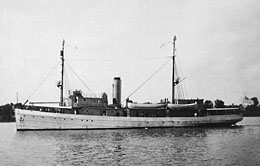
Wikipedia Public Domain Image
1955
Magnetic Striping Discovered
In a joint project with the U.S. Navy and the Scripps Institution of Oceanography, the Coast and Geodetic Survey Ship Pioneer tows the first marine magnetometer and discovers magnetic striping on the sea floor off the west coast of the United States. This discovery proves that the sea floor is spreading, providing significant credibility to the theory of plate tectonics.
1960

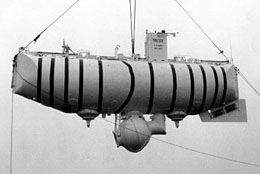
Wikipedia Public Domain Image
January 23, 1960
Deepest Ocean Dive
Jacques Piccard, son of explorer August Piccard, and two other men descend into the ocean to a depth of 35,797 feet (10,911 meters), nearly seven miles. They make the trip in the Trieste, a sturdy underwater vehicle known as a bathyscaphe. Trieste was designed by Piccard and built several years earlier. The divers discover fish and other amazing deep-sea life at these tremendous depths.

1961
Tow System Developed
The Scripps Institution of Oceanography begins development of the Deep Tow System. This sonar system becomes the forerunner of all remotely-operated and unmanned oceanographic systems today.

1962
First Underwater Habitat
Several experiments are conducted whereby people live in underwater habitats. The researchers leave the habitat for exploration and return again for food, sleep, and relaxation. The habitats are supplied by compressed air from the surface. In the first such experiment, Conshelf (Continental Shelf) One, Jacques Cousteau and his team spend seven days under 33 feet of water near Marseilles, France, in a habitat they name Diogenes.

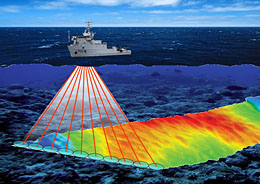
NOAA Photo Library / CC BY 2.0
1963
First Multibeam Sounding
The first operational multibeam sounding system is installed on the USNS Compass Island. This system observes a number of sounding beams to the left and right of a ship's head as well as vertically. This allows the development of a relatively accurate map of the sea floor as the ship proceeds on a survey line.

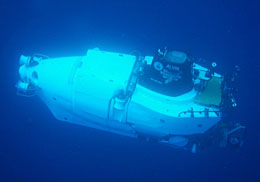
NOAA Public Domain Image
1964
Deep Sea Submersible Alvin
Alvin, a new deep submergence vehicle, is constructed by the Woods Hole Oceanographic Institute. It is the first U.S. deep diving submersible and the first deep-sea submersible capable of carrying passengers. Later that year, Alvin explores the Cayman Trough, the deepest point in the Caribbean Sea. Alvin becomes one of the most famous deep sea vehicles, making over 4,000 dives during its lifetime.

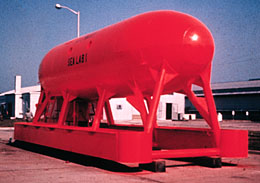
NOAA Public Domain Image
July 20, 1964
Sealab 1 Deployed
Sealab 1 is the first experimental underwater habitat developed by the Navy to research the psychological and physiological strain of extended periods spent living and working underwater. It is deployed off the coast of Bermuda at a depth of 192 feet (59 meters) below the ocean surface. Sealab 1 proves that saturation diving in the open ocean is viable for extended periods. It is currently on display at the Museum of Man in the Sea, in Panama City Beach, Florida

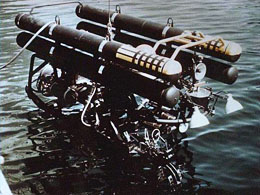
U.S. Navy Photo
1965
First Underwater Robot
The Navy develops the Cable-controlled Underwater Recovery Vehicle (CURV). It is developed by the former Pasadena Annex of the Naval Ordnance Test Station to recover test ordnance lost off San Clemente Island at depths as great as 2,000 feet (610 meters). It is designed to find and retrieve torpedoes it used in tests and training but becomes famous in 1966 when it recovers an H-bomb off Spain in 2,800 feet (853 meters) of water.


U.S. Navy Public Domain Image
October 1, 1965
Sealab 2 Deployed
Sealab 2 is deployed in the La Jolla Canyon off the coast of Scripps Institution of Oceanography in La Jolla, California, at a depth of 205 feet (62 meters). It is twice the size of Sealab 1 and is designed to house ten men at a depth of 200 feet (61 meters) for 30 days. It contains heating coils in the deck to ward off the constant helium-induced chill, and air conditioning to reduce humidity.

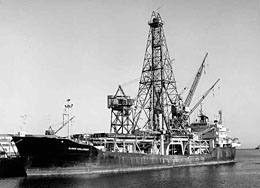
Public Domain Image
August, 1968
Deep Sea Drilling Program
The deep sea research vessel Glomar Challenger departs on a 15-year expedition known as the Deep Sea Drilling Program. The ship criss-crosses the Mid-Atlantic Ridge between Africa and South America taking core samples. The ages of the samples provide solid evidence for the theory of seafloor spreading, which will eventually give rise to the modern theory of plate tectonics.


NOAA Public Domain Image
January 28, 1969
Tektite Undersea Laboratory Deployed
The Tektite project begins as an underwater laboratory is lowered in to the water in Great Lameshur Bay, Saint John, U.S. Virgin Islands. Designed and built by General Electric Company, Tektite consists of two metal cylinders connected by a flexible tunnel. A team of four divers spend 60 days inside the habitat at a depth of 50 feet (15 meters). During the course of the project, over 60 scientists and engineers will live and work beneath the sea.

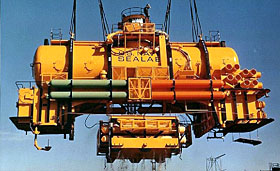
Public Domain Image
February 15, 1969
Sealab 3 Deployed
Sealab 3 is deployed off the coast of off San Clemente Island, California at a depth of 610 feet (185 meters). It uses the refurbished Sealab 2 habitat and is placed in water three times deeper. The habitat soon begins to leak and four divers are sent to repair it but are unsuccessful. During a second attempt, one of the divers is killed due to a faulty rebreather. It is believed that someone aboard the command barge is trying to sabotage the habitat's air supply. A suspect is identified but never prosecuted. Sealab 3 is retrieved from the ocean floor and scrapped.

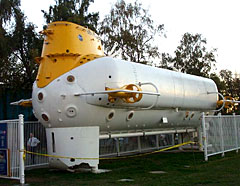
Wikipedia Public Domain Image
July 14, 1969
First Long Duration Submersible Expedition
A manned underwater submersible known as the Ben Franklin spends 30 days submerged off the coast of Palm Beach, Florida. A six-member crew led by the vehicle's creator, Jacques Piccard, study the Gulf Stream and travel a total distance of 1,444 miles (2,324 km). The voyage also serves to study the effects of long-term, continuous close confinement for long space flights.
1970

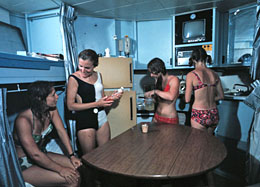
NOAA Public Domain Image
May, 1970
First All-Female Team
of Aquanauts
Celebrated oceanographer Dr. Sylvia Earle leads the first all-female team of oceanographers on a research mission aboard the Tektite underwater laboratory. The mission lasts two weeks at a depth of 50 feet (15 meters) in the U.S. Virgin Islands' Great Lameshur Bay. The aquanauts spend an average of 12 hours in the water each day as they researched ecology or coral reef fishes, human physiology and and psychology in extreme environments, and saturation diving.

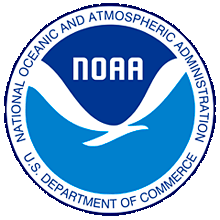
October 3, 1970
NOAA Established
The National Oceanic and Atmospheric Administration (NOAA) is established. It is an American scientific agency within the United States Department of Commerce that focuses on the conditions of the oceans, major waterways, and the atmosphere. NOAA warns of dangerous weather, charts seas, guides the use and protection of ocean and coastal resources and conducts research to provide the understanding and improve stewardship of the environment.
